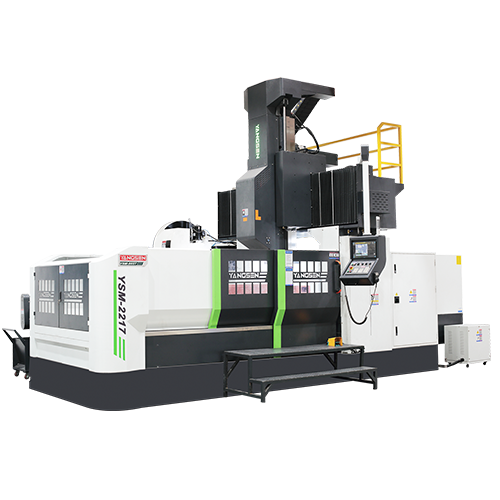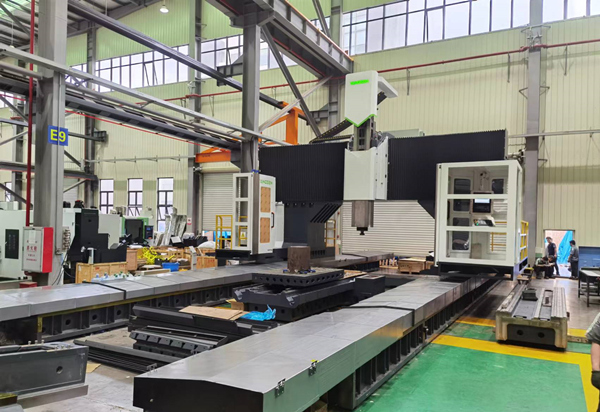Precision Machining stands as the cornerstone of modern manufacturing, forming the foundation for crafting the most intricate components with unmatched accuracy. Double Column CNC Machines are significant players in this field, reshaping industrial production by making precise cuts on large workpieces.
Double-column CNC Machines, also known as bridge-type milling machines, are engineered to deliver intricate and precise cuts on larger workpieces. Their primary objective is to elaborate designs and fulfill strict tolerance standards across a wide array of industries.
Computer Numerical Control (CNC) technology is at the core of these machines, a groundbreaking innovation that has transformed manufacturing. CNC enables the automated control of cutting tools through programmed sequences, guaranteeing precision, uniformity, and efficiency throughout the production process.
Precision cutting technologies play a pivotal role across industries, and Double Column CNC machines spearhead this transformative journey.

Double column CNC machines, also referred as gantry mills or bridge mills, stand out due to their sturdy structure and stability. Supported by two columns, they provide enhanced rigidity and precision compared to single-column machines. This design allows them to handle heavier workpieces and perform more complex machining tasks with greater accuracy.
The main components of a double column CNC machine include
● Columns: Two vertical columns that support the crossbeam.
● Crossbeam: Horizontally spans the columns and holds the machine's spindle or cutting tool.
● Bed or Table: The surface where the workpiece is secured for machining.
● Guideways: Provide support and precise movement for the machine's axes.
● Control System: Manages the CNC operations, controlling tool movement and cutting parameters.
These machines often have a robust and heavy-duty build, using high-quality materials to ensure stability and accuracy during machining operations.
Advantages:
● Rigidity: The double column design enhances stability, reducing vibrations and enabling more accurate machining of larger or heavier workpieces.
● Precision: Provides exceptional accuracy in shaping complex components by minimizing deviation.
● Versatility: Can work with many materials and perform different machining tasks.
Limitations:
● Size and Space: Double column CNC machines are generally bigger, needing more floor area than single-column versions.
● Cost: They can be more expensive due to their robust construction and advanced capabilities.
● Complexity: Operating and maintaining these machines may demand specific expertise and knowledge and skills.
These machines are favored in industries that value precision and stability for crafting sizable and intricate parts, such as aerospace, automotive, and tooling sectors.
Precision cutting is vital in numerous industries, forming the base for effective manufacturing, construction, and design procedures. Its significance spreads widely because of its unparalleled accuracy and attention to detail.
Precision cutting plays a critical role across numerous industries, such as :
● In manufacturing, precision cutting is pivotal for crafting intricate components, and nurturing the creation of high quality goods across industries such as automotive, aerospace, and electronics.
● In the medical field, precise cutting is crucial for creating medical devices, enabling the crafting of detailed tools and implants with exact accuracy.
● Engineering and construction depend heavily on accurate cuts to ensure materials fit precisely, enhancing structural integrity in different projects.
● In electronics, micro-level precision cutting is vital for creating intricate circuitry.
● In artistic fields, precision cutting aids in crafting detailed and fine pieces.
● Precision cutting ensures precise measurements and shapes, minimizing material waste and elevating product quality through exactness.
● Efficiency: It streamlines production by reducing errors, which boosts productivity and cost-effectiveness.
● Quality: High precision results in superior quality end products that meet stringent industry standards.
● In microelectronics, crafting microchips and electronic parts requires precise cutting to achieve intricate designs and miniaturization.
● Textile manufacturing relies on precise cutting to ensure garments have accurate patterns and sizes.
● Precision cutting holds significant importance in manufacturing automotive parts, ranging from engine components to intricate parts.
Precision cutting extends its influence across industries valuing accuracy and reliability. Its ongoing impact drives progress across various sectors, enabling the development of advanced and top-quality products.
● Calibration: Regular calibration ensures the machine operates within specified tolerances, optimizing its accuracy.
● Maintenance: Proper upkeep of components like guideways, ball screws, and spindle ensures smooth movement and precision during machining.
● Tool Quality: High-quality cutting tools with precise geometry and suitable coatings enhance accuracy and surface finish.
● Tool Wear: Regular inspection and replacement of worn-out tools prevent dimensional inaccuracies.
It's crucial to know the special traits of materials like hardness, density, and thermal conductivity to adjust cutting settings for perfect precision. Also, securing the workpiece tightly reduces vibrations, ensuring a steady and accurate cutting process.
Employing advanced CAD/CAM software facilitates precise machining instructions by enabling sophisticated design capabilities and generating accurate toolpaths. Additionally, adept programming expertise plays a crucial role in optimizing toolpaths, speeds, and feeds, ensuring both accuracy and efficiency during the machining process. Furthermore, conducting virtual simulations and testing of toolpaths aids in preemptively identifying potential issues before actual machining, thereby elevating precision levels.
These factors contribute significantly to the precision achievable with double column CNC machines. Proper attention to these elements ensures consistent and accurate cuts for various applications.
Alignment of the machine's components is imperative to ensure precise movements, necessitating accurate alignment for optimal functionality. Regular calibration is essential to uphold accuracy within specified tolerances, requiring consistent calibration practices. Meticulous securing of workpieces during fixture setup is crucial to prevent any movement or vibrations that may compromise the machining process.
Selecting high-quality tools with suitable geometry and coatings tailored to the specific material being machined is essential for precision. Furthermore, using advanced CAM software to create accurate and efficient toolpaths, while considering factors like cutting forces and tool engagement, greatly helps achieve precision in machining operations.
● Step-by-step machining involves breaking down complex cuts into smaller, more manageable steps to retain precision.
● Optimizing speeds and feeds means adjusting cutting speeds and feed rates according to material and tool characteristics to prevent overheating and tool wear.
● Using coolant properly helps regulate temperatures, diminish thermal distortion, and prolong tool life.
Achieving precise cuts involves managing vibrations through strategies like damping or using anti-vibration toolholders and adjusting cutting parameters to minimize their impact. Controlling temperatures during machining prevents thermal expansion and contraction, safeguarding precision. Regularly inspecting tools and employing monitoring systems to detect early wear helps prevent dimensional inaccuracies. Mastering precision cutting demands meticulous setup, careful tool selection, and strategic machining approaches. Continuous monitoring, adjustment, and a proactive stance toward challenges contribute to consistent and accurate results with double column CNC machines.
Use CAM software that can adjust toolpaths in real time to optimize speeds and feeds as cutting conditions change. Apply trochoidal or high-efficiency milling techniques to keep the tool engaged consistently, reducing heat generation and improving precision while machining.
● High-Performance Tool Materials: Consider advanced tool materials such as carbide grades or ceramic inserts for enhanced tool longevity and better performance.
● Toolpath Optimization: Optimize toolpaths using specialized techniques like adaptive clearing or high-speed machining to improve tool efficiency and minimize wear while retaining precision.
● In-process Monitoring Systems: Use advanced monitoring systems that offer real-time data on tool condition, temperature, and vibrations, enabling immediate adjustments to uphold precision.
● 5-axis Machining: Employ 5-axis machining capabilities to access various sides of a workpiece, enabling intricate cuts with enhanced precision and reducing the need for repositioning.
By employing advanced strategies like dynamic toolpath adjustments, cutting-edge tool materials, and the latest monitoring and machining technologies, manufacturers can attain unmatched levels of precision and efficiency in CNC machining processes.

Achieving precision cuts with Double Column CNC machines requires a skilled workforce, highlighting the crucial significance of training for operators and programmers. Mastery in handling these machines necessitates a profound understanding of their intricacies, spanning from machine operations to programming languages.
Operators must excel in machine setup, calibration, and daily operations. This involves aligning components, ensuring precise calibration, and performing routine maintenance for optimal performance.
Programmers are vital in converting design specs into machine-readable code. Proficiency in programming languages, especially those tailored for CNC machines, is crucial.
Providing operators and programmers with troubleshooting skills is crucial. In a dynamic manufacturing setting, the ability to swiftly identify and resolve issues minimizes downtime, ensuring uninterrupted operation of Double Column CNC machines.
Precision cutting is constantly evolving with the emergence of new technologies and techniques. Continuous learning initiatives are crucial to ensure operators and programmers stay updated on these advancements.
Arranging workshops and seminars offers professionals a chance to discover the latest trends, technologies, and best practices. These events promote sharing knowledge and collaboration within the precision cutting community.
Tailored skill enhancement programs catered to the specific needs of operators and programmers are invaluable. These programs may explore advanced subjects, like mastering intricate toolpaths or optimizing machine configurations for specific materials.
Cross-training initiatives, where operators understand programming aspects and vice versa, enhance the overall skill set of the workforce. This versatility ensures a more agile and adaptable team capable of handling diverse challenges.
Access to educational resources is crucial for professionals looking to enhance their precision cutting skills. Here are some valuable resources and tools:
Many online platforms provide courses covering CNC machining, precision cutting, and related subjects. These courses often feature video lectures, interactive simulations, and assessments to make learning more engaging and effective.
Engaging in industry forums and online communities offers professionals a space to discuss challenges, share experiences, and seek advice. This collaborative environment nurtures a sense of community and supports ongoing learning.
Simulation tools allow operators and programmers to simulate machining processes in a virtual environment. This hands-on experience is invaluable for understanding the impact of different parameters on precision and efficiency.
Equipping operators and programmers with these resources and tools enhances their capabilities, ensuring they stay at the forefront of precision cutting technologies.
Delving into emerging technologies such as hybrid machining, additive manufacturing integration, and enhanced sensor technology is crucial to understanding how they reshape precision cutting, offering insights into future possibilities. Discussing the evolution of smarter, more autonomous machining systems provides enlightening future prospects, highlighting how these advancements could elevate precision, speed, and adaptability in precision cutting technologies. Exploring the potential impacts of advanced precision cutting technologies on manufacturing sectors becomes crucial in explaining how these innovations might drive efficiency, shorten lead times, and introduce new design possibilities across industries, essential for comprehending their implications.

Precision cutting is fundamental in high-quality manufacturing across various industries, guaranteeing compliance with strict standards and precise specifications crucial for industrial excellence. Achieving mastery in this field demands a multifaceted approach, combining expertise in machine operations, tooling, software utilization, and continual skill development. It requires a steadfast commitment to ongoing improvement, acknowledging that excellence in precision cutting is a dynamic pursuit.
Embracing a culture of continuous improvement and embracing technological advancements are vital strategies for remaining at the forefront of precision manufacturing. Encouraging professionals to strive for ongoing excellence fosters innovation and fosters growth. This comprehensive exploration delves into the intricacies of precision cutting techniques, their wide-ranging applications across industries, and the essential strategies required for precision with Double Column CNC machines. Mastery in precision machining necessitates a profound understanding of machine dynamics, tooling considerations, software utilization, and continual skill enhancement. Embracing advancements and nurturing an environment of continuous learning will be instrumental in mastering evolving precision machining techniques.